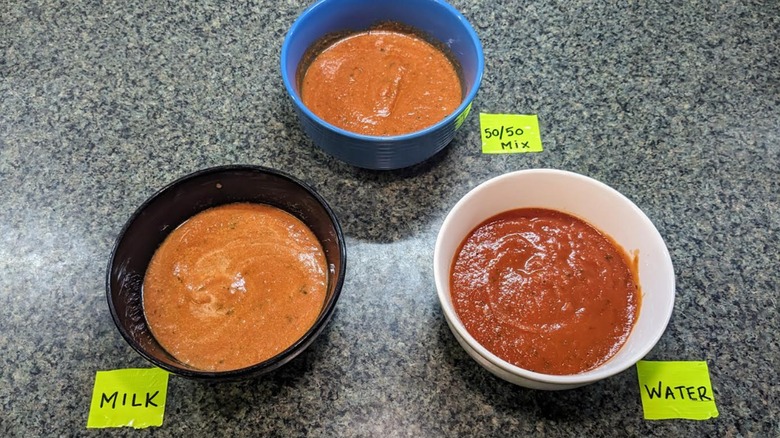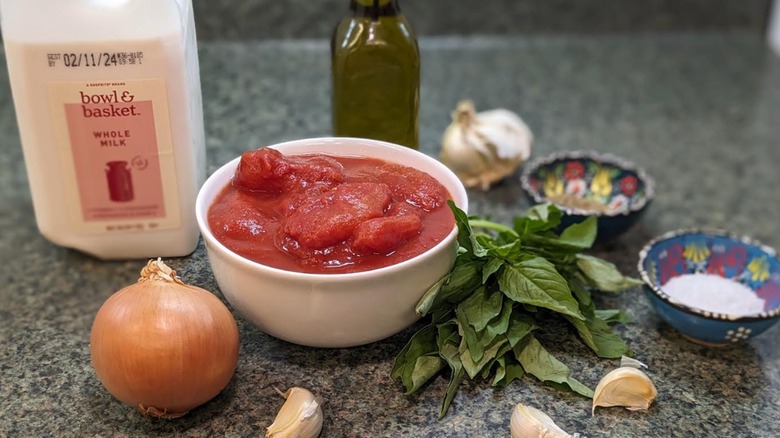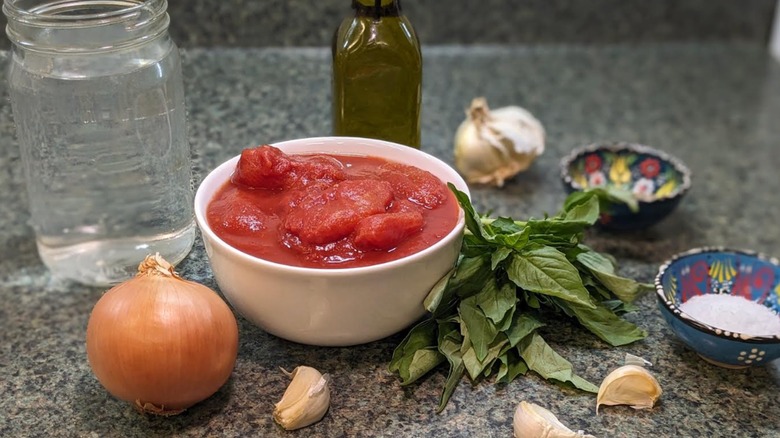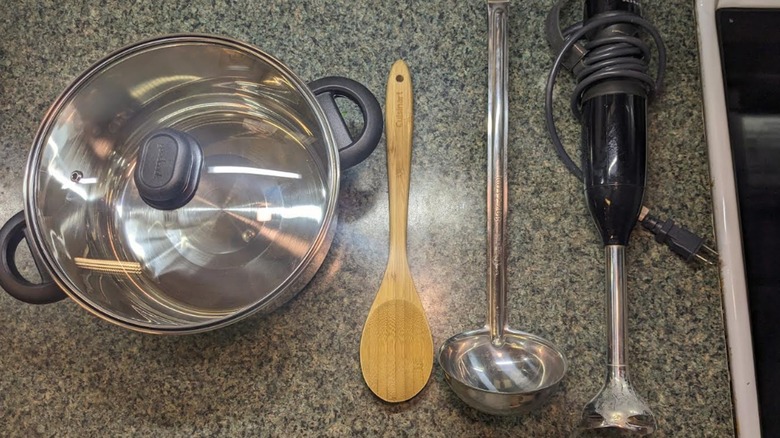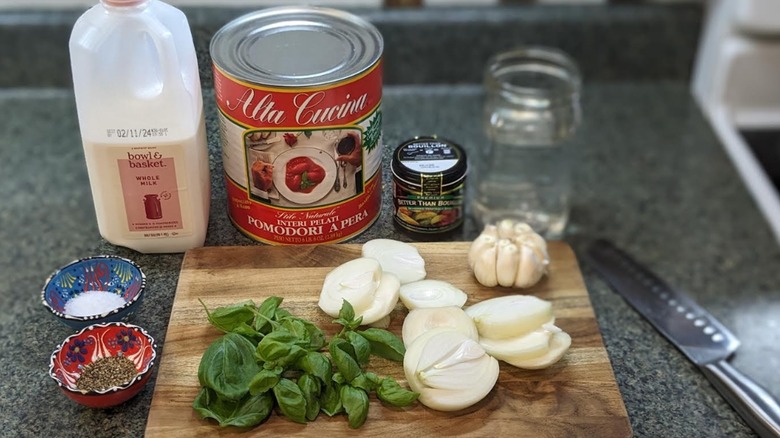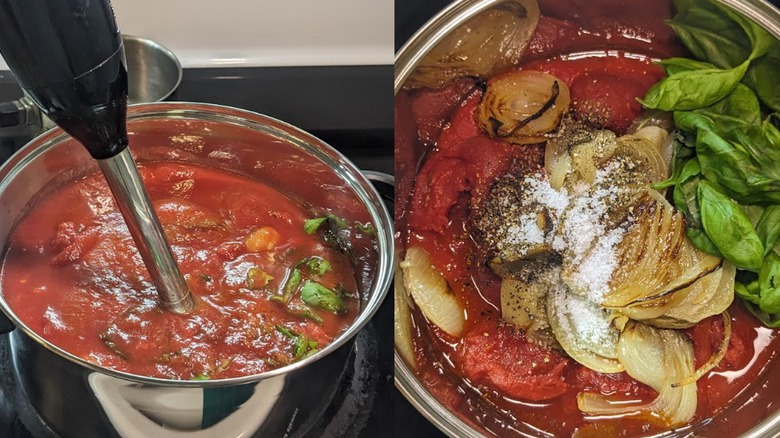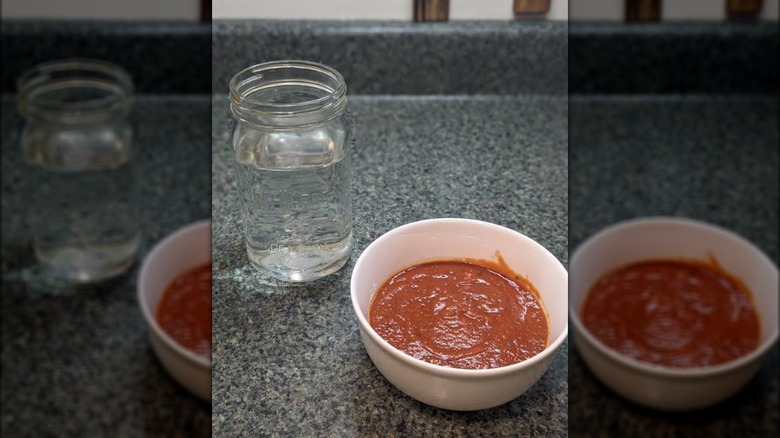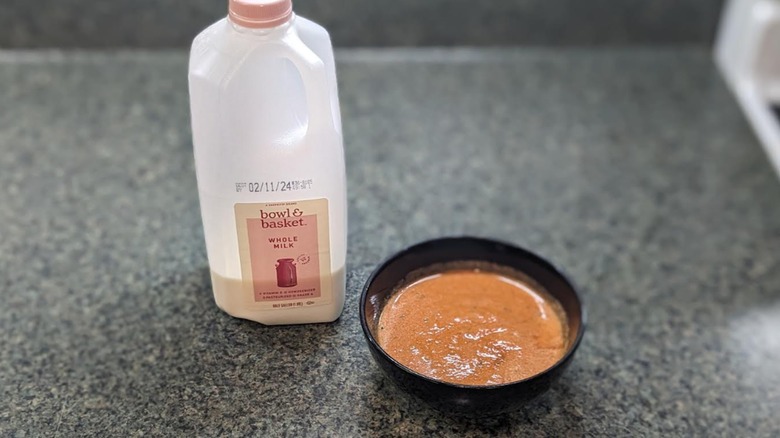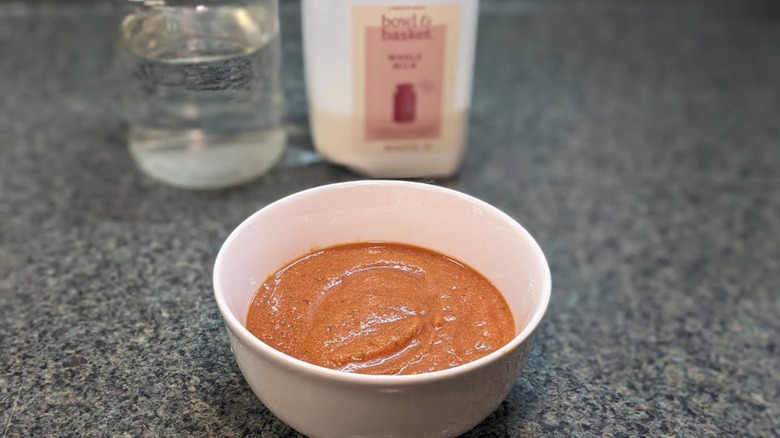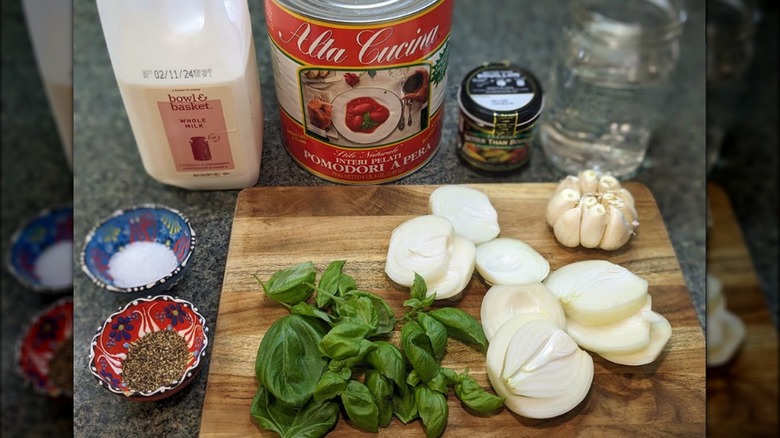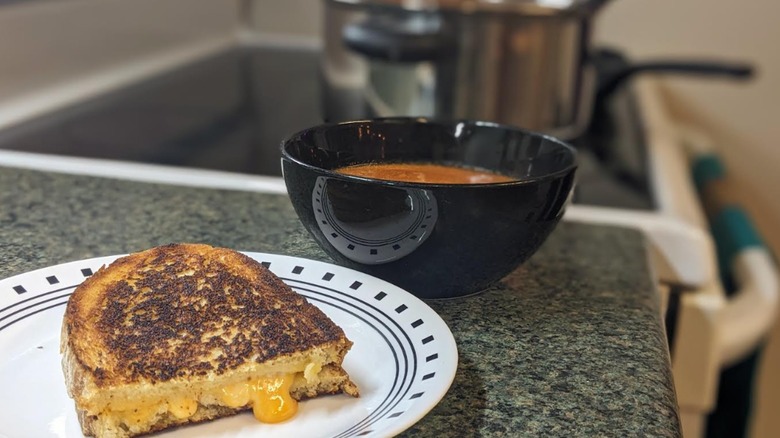Water Vs. Milk: Which Is The Better Way To Make Tomato Soup?
There's nothing quite like a comforting bowl of hot tomato soup to ward off the chill on a cold day. Whether you serve it with crackers or grilled cheese or just dive into a hearty bowl all on its own, this flavorful soup is one of the ultimate nostalgic comfort foods. There are a plethora of hacks to get the most out of your homemade tomato soup, like adding orange juice to balance out the flavors or topping it with croutons or roasted nuts for extra texture. But tomato soup can be made delicious with simple methods and just a few common ingredients, like garden-fresh herbs and ripe tomatoes bursting with juicy tartness.
Soup, being one of the more versatile dishes out there, can be made nearly any way you like. Just combine your favorite ingredients with broth, and you'll have a filling meal to warm you up on the chilliest winter day. But broth can be polarizing — some like a thin, water-based broth with only a little bouillon added, while others prefer a thicker, creamier soup made with milk or cream and loaded with savory flavors. Depending on your preference and the ingredients in your soup, both methods have the potential to make a delicious meal. To finally put the age-old debate about this timeless dish to rest, we've decided to try making soups with water, milk, and a combination of the two to see which one comes out on top.
When made with milk, tomato soup should be rich and creamy
Not all soups are created equal. A soup made with milk is usually richer and more luxurious than one made with just water or stock. This addition helps make the soup feel more comforting. Adding milk or cream to a soup can balance contrasting tastes and help ingredients that don't typically mesh blend seamlessly. Plus, the extra calories in milk or cream can make for a more filling soup served solo and without any accompanying sides.
For those who shy away from dairy or have an allergy, coconut milk is a dairy-free way to thicken up tomato soup and make it just as (if not more) decedent as dairy milk. All types of milk will make soups richer without adding a thickener like cornstarch or flour and often positively impact flavor. We hypothesized that our milk-based soup would be more silky smooth, thick, and indulgent but that the fattiness of the milk may mask the flavors of the tomatoes and seasonings.
Using only water should allow bold flavors to shine through
Sometimes, the simpler the addition, the better it works in the recipe. An addition as straightforward as water — which imparts no additional tastes or textures and merely thins the soup to the desired consistency — should leave every delicate flavor undisturbed. Adding only water should allow the bright, vibrant flavors of the tomatoes and the fresh taste of basil to stand front and center of each bite. Although the soup may be a little thinner and less filling than one made with milk, a soup made with water might be perfect to serve alongside a complex and carb-heavy main dish.
We theorized that, with only the addition of water to our tomato soup, it should take on a vivid, bright red color. The distinctive aromas and tastes of each ingredient should be blatantly apparent, with basil likely being the most forward flavor. The tomatoes should be tangier than they would be in a soup made with milk. Therefore, this would make for a zestier dish that might pair well with spicy ingredients, like chili flakes or hot sauce.
Cooking equipment
Your equipment is just as important as the ingredients you use. Tomato soup requires more heavy-duty equipment than many chunky and brothy soups might need, like a sturdy stock pot. We chose one that left ample room for the amount of soup we planned to make. Splashing is common with this recipe, so filling a stockpot to the brim would make the kitchen a red, sopping mess by the time we're finished. Since preparing acidic tomato soup may cause interactions with reactive cookware, like cast iron, we opted for non-reactive stainless steel instead. Next, we needed a sharp chef's knife — a tool that every home cook needs to have on hand — to cut our onions. Dull knives are dangerous and much harder to work with, so we recommend investing in a knife sharpener if you don't already have one as part of your home kitchen arsenal.
The most important tool for this soup is a truly underrated piece of kitchen equipment: an immersion blender. A regular blender works as a substitute for an immersion blender, but the latter allows us to pureé the soup directly in the stockpot, which means less time spent preparing the meal and fewer dishes to clean afterward. Finally, we found a sturdy spoon to stir the soup with and a ladle for serving.
Ingredients
Tomato soup is celebrated for its versatility and straightforward recipe. So, to keep our test as error-free as possible, we kept our soup simple by following a standard roasted tomato soup recipe for our milk-based soup and replicating it for a water-only version. We started, of course, with tomatoes. The best tomatoes for homemade tomato soup are San Marzano tomatoes from Italy, but considering the variety isn't often grown in the U.S., we opted for a copycat domestic variety. We opted for canned tomatoes rather than fresh ones for this recipe to ensure that the flavor was standardized.
We also selected a recipe that called for basil since we wanted it to be flavor-forward in the dish. After all, you can never go wrong with a classic tomato and basil combination. A common mistake made with tomato soup involves mixing too many herbs and creating contrasting flavors that ruin the dish, so we stuck with a single herb. Next, we set aside our most pivotal ingredients for the test: water and whole milk.
Finally, we grabbed the non-herb aromatics, onions and garlic, to bolster the dish. The soup would turn out bland without the added flavors from these savory veggies. For an added depth of flavor, we also used bouillon paste, salt, and pepper.
How we make tomato soup
We used the same cooking method for each test batch (milk, water, and a 50/50 mix). First, we start with a crucial step that, if forgotten, would render our soup significantly less savory and delicious: We roasted all of our veggies. We spread out the tomatoes, onion, and garlic (which we covered in foil to ensure an even roast across all the cloves) on baking sheets with a drizzle of olive oil. After about 40 minutes in the oven, we put every ingredient into one stockpot and simmered it down. Once the soup started to smell fragrant, we used the immersion blender to blend it until it was completely smooth. If we noticed the soup was too thick, we added more of whatever liquid we used for that batch.
We allowed each batch to simmer for a few minutes before serving. While typically, a garnish of basil or a drizzle of cream on top would enhance the visual appeal, we omitted this step to prioritize our tasting experience over aesthetics as much as possible.
Test: Water-based tomato soup
Much to our surprise, this soup retained a relatively thick consistency despite adding a substantial amount of water to dilute it. It took on a deep, dark red color, with the flecks of basil only slightly noticeable throughout the soup. What astonished us the most was how similar our tomato soup looked to marinara sauce. We realized that this shouldn't have come as a surprise, considering marinara sauce requires ingredients similar to those in the recipe we used to make this soup.
After conducting our taste test, we discovered that this soup not only looked like marinara sauce, but it tasted very similar. The only noticeable difference between tomato sauce and our tomato soup was its consistency; tomato sauce would have been thicker. It was exceptionally tangy, verging on the edge of slightly sour, and could have used something to balance out the bitterness, like baking soda or sugar. However, we were impressed with how pronounced the flavor of basil was in this soup, and the deeply sweet and zesty taste of high-quality tomatoes was unmistakable. We surmised that we likely wouldn't have enjoyed this soup at all if it had been made with unripe or low-quality tomatoes.
Test: Milk-based tomato soup
Next, we tried our soup made with milk. Unsurprisingly, this soup was noticeably creamier and less tangy and sour than our soup made with only water. It took on an attractive dark, orange-pink color that looked particularly appealing with the little green flecks of pureéd basil floating throughout. This tomato soup was also noticeably thicker but not as thick as we initially thought it would be. It had a much smoother texture than the soup made with water, which, along with the added thickness, made it taste much more like a meal on its own and less like a dipping or pasta sauce.
The soup made with milk was much more decadent, but there was something off about the consistency, likely due to the addition of room-temperature milk. To prevent the cream from curdling in soup, you should always heat it up before adding it to the pot. Although this time-consuming step would make the soup noticeably creamy and rich, it means that the process of making soup with water is much more straightforward.
Test: 50/50 tomato soup
Finally, we tried a soup made with half water and half milk. It was almost the same color as the soup made entirely with milk but was just slightly darker and redder. The tomato color was unmistakable, but the slight addition of milk gave it a delicate orange hue reminiscent of a sunset. It was about the same consistency as the soup made with water and came out thinner than pasta sauce. Overall, we were quite impressed by the aesthetic appearance of the soup.
This soup really did have the best of both worlds. It was creamy and took on a subtle richness, and the basil flavor was strong. But it wasn't as filling as the soup made entirely with milk, which didn't surprise us. Instead, it retained a pasta sauce-like taste similar to the soup made with water. Unlike the water-based soup, this soup was much milder and significantly less tangy, but the flavor of high-quality tomatoes still shone through in each bite. The creaminess of this dish was subtle, making it much less luxurious than the soup made with only milk.
Verdict: Which soup was best overall?
After considering the taste, aesthetic appeal, and filling quality of each, we determined that the soup made with milk was superior to the rest. The creaminess from the fat was undeniably more appetizing than the bright tang of the water-based soup. Although this dish's basil flavor was less pronounced, its soft and subtle essence was still apparent. We enjoyed the pinkish color and smoother texture above all else. A soup that's too chunky when it should be velvety can be offputting, and we found that to be the case with the water-based soup.
We loved how the milk subdued the sharp bite of the tomato flavor, which we felt in full force in the water-based soup. The milk-based soup was far from sour or reminiscent of a pasta sauce, and it would easily make a satisfying meal all on its own. Next time, we might try adding even more milk and a little more basil to compensate for the milk's tendency to overpower the fresh-tasting herb. When we do that, we'll warm the milk before adding it to our soup.
Verdict: Which soup was best for serving with grilled cheese?
We can't have a lengthy discussion about tomato soup without talking about grilled cheese. After all, there might not be a better pairing. Although we enjoyed the soup made with milk the best overall, we concluded that the creamy soup is best served all on its own, maybe only with a garnish of croutons. It was much too hearty and filling to be served with a carb-heavy food like grilled cheese, plus the milk and the melty cheese would make for a dairy overload.
We preferred the 50/50 mix for our tomato soup and grilled cheese meal. The slight addition of milk was enough to subdue the tang and bitterness of the tomatoes, but it wasn't so milk-heavy to make it ultra-filling or decadent. This soup was perfect for dipping toasty, crusty bites of a hot grilled cheese sandwich. We used extra sharp cheddar and Colby-jack cheeses in our sandwich for a mild and sharp mix, which complemented the soup's flavor notes well. We surmised that a grilled cheese made with a Swiss and mozzarella mix would have also paired well with this soup and offered a similar blend of strong and smooth tastes.
